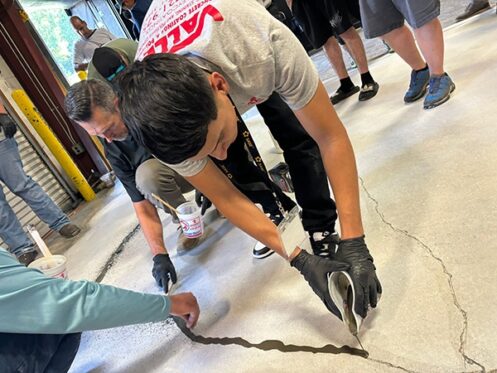
Concrete might seem solid, but it can crack, chip, or sink over time, making your once-smooth garage floor look worn out. These cracks can collect dirt, let in water, and even lead to bigger issues down the road. While it’s tempting to grab a patch kit and try fixing the cracks yourself, not all concrete repairs are as simple as they seem.
Why Garage Floors Crack in the First Place
You probably didn’t think much about your garage floor when you moved in. It’s just concrete, right? It’s supposed to last forever. But then, one day, you noticed a small crack. Maybe it wasn’t a big deal at first. But over time, it grew wider. Now, every time you pull into the garage, your tire thumps over it. You might even catch your toe if you’re not watching where you step. That little crack has turned into something you can’t ignore.
Concrete seems tough, but it doesn’t stay perfect forever. Temperature changes are one of the biggest reasons you might end up with cracks. In the summer, the heat makes the concrete expand. Then, when it gets cold, it shrinks. The constant expansion and shrinking put pressure on the concrete. When it can’t take it anymore, cracks start to form. Water can make things even worse. Rain can sneak into those tiny cracks, and when it freezes, it swells up, forcing the crack to grow bigger. After a few seasons of freezing and expansion, a hairline crack will grow into a noticeable gap.
Sometimes, the problem is what’s underneath. If the ground under your garage wasn’t packed down well before the concrete was poured, it can settle over time. That leaves empty spaces under the slab. When your car drives over it, the weight pushes the concrete down. You may start seeing dips, cracks, or even whole sections that sink lower than the rest.
When Small Cracks Start Turning into Big Problems
A small crack might seem harmless at first. You may be tempted to ignore it or fill it in with a little patch from the hardware store. But concrete cracks rarely stay small. Once they start, they will get worse.
You might not notice at first, but those cracks let moisture in. That water seeps under the slab. When temperatures drop, water freezes and expands. The crack gets pushed open a little wider. By the time spring rolls around, you might find that the crack you thought was done growing has doubled in size.
Water isn’t your only enemy when it comes to concrete cracks. Dirt can also settle in them, and when debris builds up, proper repairs become harder. The concrete might start flaking around the edges, especially if you drive over the cracks often. Before you know it, that tiny line has deteriorated into an unsightly pothole in your garage.
Why Store-Bought Patch Kits Don’t Always Work
Concrete patch kits promise quick fixes, but the reality is much different. The repair might work for a while, offering cosmetic improvement. They are unlikely to fix the problem for good, however. Patching a concrete crack is much like putting a bandage on a leaking pipe. The drip might be contained for now, but the problem will continue until the underlying source is found and addressed. Similarly, you’ll need to find the source of the crack, address it, and repair the crack properly to prevent the problem from spreading and worsening.
Concrete moves. If the ground under your slab is shifting or water keeps getting in, that patch will crack again. Sometimes, it breaks apart completely, leaving you right back where you started. Other times, the crack reappears a few inches away. You end up chasing it across your garage, spending money on patches every year.
When You Might Need More Than a Simple Repair
There are times when a crack is more than just a crack. If you notice that part of your garage floor is sinking or one side of a crack is lower than the other, you’re likely dealing with a bigger issue. That usually means the ground underneath has settled unevenly.
You might notice the problem when you back your car out. Maybe one wheel dips lower than the others as you cross a certain spot. Or you feel a bump every time you pull in. Those are signs that the concrete is no longer resting evenly.
Fixing this kind of problem often means raising the slab. Professionals use something called slab jacking, where they inject a material underneath the concrete to lift it back into place. This is not something you can do with a bag of concrete from the store. Getting it done right means your floor will be level again, and you won’t have to worry about those cracks deteriorating every year.
Right Way to Repair and Prevent Future Cracks
Getting your garage floor fixed properly starts with figuring out what’s causing the problem. A professional can check if it’s just a surface crack or something deeper. Once they know what they’re working with, they can decide if the concrete needs patching, leveling, or maybe even a full replacement.
When repairs are done professionally, they use materials that bond better with the existing concrete. These materials flex a little with temperature changes, which helps prevent future cracks. They also make sure any gaps underneath the slab are filled so that your floor stays supported.
After repairs, keeping your garage floor in good shape is mostly about paying attention. If you notice small cracks forming, get them checked before they grow. Keeping the floor clean and making sure water isn’t pooling near the edges helps, too. It might seem like a small thing, but those little steps can keep you from needing big repairs later.
Why Calling a Professional Saves You Time and Money
Trying to fix your garage floor on your own can sound like a good idea until you’re halfway through the job and things don’t go as planned. Whether the crack is deeper than you realized or the patch doesn’t set right, you could waste your weekend feeling frustrated and overwhelmed and end up with a floor that still isn’t fixed.
Professionals know how to handle concrete repairs the right way. They can spot problems you might miss, like moisture under the slab or poor drainage. They also have the right tools and materials to make the repair last.
A good repair means you won’t be patching the same crack every year. You get a smooth, level surface that holds up under your car and through all the temperature changes outside. This is one of those fixes that’s worth getting right the first time.
Have Our Professionals Fix Your Garage Floor
A cracked, uneven garage floor can be more than just an eyesore: It can lead to bigger problems if water seeps in or the damage spreads. Whether you’ve got small cracks or a floor starting to feel like a mountain range, getting it fixed properly will give you a smooth, sturdy surface that lasts for years. At Valley Concrete Coatings & Polishing, we offer a variety of concrete flooring services, including polishing, sealing, staining, grinding and, of course, repair.
If you’re ready to get your garage floor looking good again, call Valley Concrete Coatings & Polishing in Phoenix, AZ today for expert concrete flooring services.










